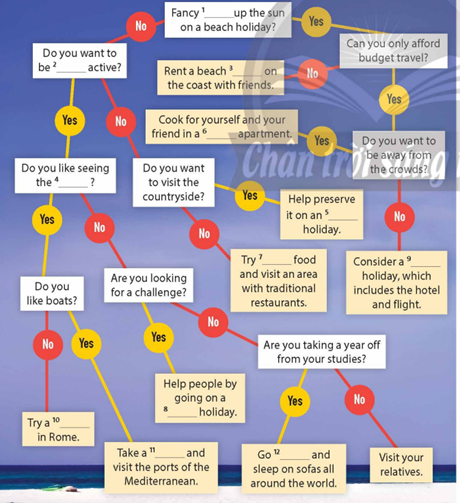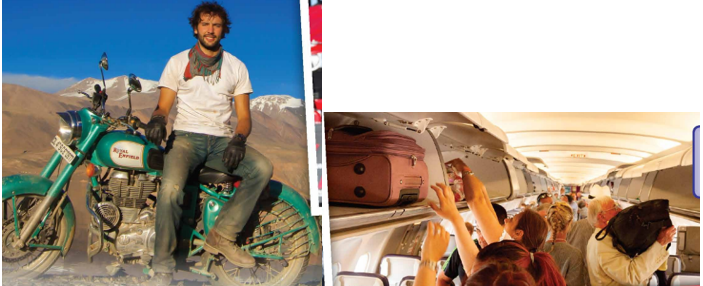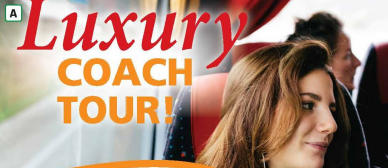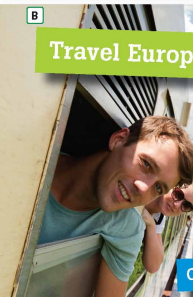Câu 41 :
Travelling online
If you haven't got time to go travelling, you can still enjoy it by following a traveller's experiences on their blog.
Here are three of the most interesting and unusual globetrotters online!
Α
At the age of seventeen, Alex Chacón set off from his home in El Paso, Texas and went for a motorbike ride. Alex's thirty-day tour of the USA took in California, Washington and Florida and gave Alex an aim in life: to travel the world on his motorbike.
Although Alex usually travels alone, he has shared his experiences on his blog. While travelling, Alex videos himself doing all sorts of activities against breathtaking backgrounds of remote jungles, deserts and mountains. On one trip, he filmed himself by moving in a 360° circle so that all the famous landmarks would be included.
During Alex's motorcycle expeditions, he regularly stops to take part in volunteering projects at orphanages that he comes across on his route. Furthermore, he uses his blog to raise donations for orphans.
Alex is now planning to cross Africa, Europe and Asia. It seems that by the 5 time he's thirty, Alex will have ridden his bike across most of the planet!
B
Dutch actress Manon Ossevoort has dreamed of travelling from Europe across Africa to the South Pole for years, and she chose a slow form of transport: a tractor. Manon only averaged 5 km/h as she drove, but that allowed her to get to know the hospitable people in villages where she stopped over for the night. She would explain why she was going to the South Pole and ask people to follow her blog and write down their own dreams. She promised to build a snowman when she arrived at her destination and leave all their dreams inside it. The idea was popular and Manon received thousands of dreams on pieces of paper and in emails. Finally, on 9 December 2014, Manon's dream came true, and she pulled up in a big red tractor at the South Pole. She then built a snowman and left a time capsule inside it with all the dreams she had collected. Manon explained on her blog that when the time capsule is opened in eighty years' time, future generations will be able to read something about our lives and our hopes for the future.
C
Have you ever travelled with no luggage? That was the question Rolf Potts aimed to answer on the 'no-baggage challenge'. However, the task wasn't simply a question of going off for a week to soak up the sun on a beach. Rolf had to travel 50,000 km by plane and get around eleven countries in 42 days with just the things he could carry in his pockets. Would he be able to do it?
Rolf was certainly well qualified enough to try. He was an experienced traveller who wrote a blog about budget travel. Now he planned to update it with regular reports about travelling extremely light.
His first 'no-baggage challenge' entry listed the items he took with him: a toothbrush and toothpaste, a small bottle of soap, a mobile phone and charger, deodorant, sunglasses, a passport, cash and a credit card. His second entry explained that he had got into the habit of washing his clothes before going to bed during his trips. By the third entry, he was really enjoying luggage-free travel.
Potts said that he would never pack any 'just in case' items again, because the imagined situations that they were packed for would never happen.
Tạm dịch
Du lịch trực tuyến
Nếu không có thời gian đi du lịch, bạn vẫn có thể tận hưởng bằng cách theo dõi trải nghiệm của một lữ khách trên blog của họ.
Dưới đây là ba trong số những người đam mê khám phá thế giới thú vị và khác thường nhất trên mạng!
Α
Năm mười bảy tuổi, Alex Chacón rời nhà ở El Paso, Texas và đi xe máy. Chuyến du lịch Hoa Kỳ kéo dài 30 ngày của Alex diễn ra ở California, Washington và Florida và mang đến cho Alex một mục tiêu trong cuộc đời: đi du lịch vòng quanh thế giới bằng xe máy của mình.
Mặc dù Alex thường đi du lịch một mình nhưng anh ấy đã chia sẻ kinh nghiệm của mình trên blog của mình. Trong khi đi du lịch, Alex quay video chính mình thực hiện đủ loại hoạt động trên bối cảnh ngoạn mục của những khu rừng, sa mạc và núi non xa xôi. Trong một chuyến đi, anh ấy đã tự quay phim bằng cách di chuyển theo một vòng tròn 360° để bao gồm tất cả các địa danh nổi tiếng.
Trong các chuyến thám hiểm bằng mô tô của Alex, anh thường xuyên dừng lại để tham gia các dự án tình nguyện tại trại trẻ mồ côi mà anh tình cờ gặp trên đường đi. Hơn nữa, anh ấy còn sử dụng blog của mình để quyên góp cho trẻ mồ côi.
Alex hiện đang có kế hoạch đi khắp Châu Phi, Châu Âu và Châu Á. Có vẻ như vào năm thứ 5 anh ấy ba mươi tuổi, Alex sẽ đạp xe đi khắp hành tinh!
B
Nữ diễn viên người Hà Lan Manon Ossevoort đã mơ ước được đi du lịch từ Châu Âu qua Châu Phi đến Nam Cực trong nhiều năm và cô đã chọn một hình thức vận chuyển chậm rãi: máy kéo. Manon chỉ chạy với tốc độ trung bình 5 km/h khi cô lái xe, nhưng điều đó giúp cô làm quen với những người dân hiếu khách ở những ngôi làng nơi cô dừng chân qua đêm. Cô ấy sẽ giải thích lý do tại sao cô ấy lại đến Nam Cực và yêu cầu mọi người theo dõi blog của cô ấy và viết ra những giấc mơ của riêng họ. Cô ấy hứa sẽ làm một người tuyết khi đến nơi và để lại tất cả ước mơ của họ bên trong đó. Ý tưởng này rất phổ biến và Manon đã nhận được hàng nghìn giấc mơ trên những tờ giấy và email. Cuối cùng, vào ngày 9 tháng 12 năm 2014, giấc mơ của Manon đã thành hiện thực và cô đã đến được trên một chiếc máy kéo lớn màu đỏ ở Nam Cực. Sau đó, cô ấy làm một người tuyết và để lại một viên nang thời gian bên trong đó với tất cả những giấc mơ mà cô ấy đã thu thập được. Manon giải thích trên blog của mình rằng khi viên nang thời gian được mở ra sau 80 năm nữa, các thế hệ tương lai sẽ có thể đọc được điều gì đó về cuộc sống và hy vọng của chúng ta về tương lai.
C
Bạn đã bao giờ đi du lịch mà không có hành lý chưa? Đó chính là câu hỏi mà Rolf Potts muốn trả lời trong 'thử thách không mang hành lý'. Tuy nhiên, nhiệm vụ không chỉ đơn giản là đi tắm nắng trên bãi biển trong một tuần. Rolf đã phải di chuyển 50.000 km bằng máy bay và đi vòng quanh 11 quốc gia trong 42 ngày chỉ với những thứ anh có thể mang theo trong túi. Liệu anh ấy có thể làm được điều đó không?
Rolf chắc chắn có đủ trình độ để thử sức. Anh ấy là một du khách giàu kinh nghiệm và đã viết blog về du lịch tiết kiệm. Bây giờ anh ấy dự định cập nhật nó với những báo cáo thường xuyên về việc đi lại cực kỳ nhẹ nhàng.
Mục 'thử thách không hành lý' đầu tiên của anh liệt kê những món đồ anh mang theo: bàn chải đánh răng và kem đánh răng, một chai xà phòng nhỏ, điện thoại di động và bộ sạc, chất khử mùi, kính râm, hộ chiếu, tiền mặt và thẻ tín dụng. Mục thứ hai của anh ấy giải thích rằng anh ấy đã có thói quen giặt quần áo trước khi đi ngủ trong những chuyến đi. Đến lần nhập cảnh thứ ba, anh ấy thực sự thích thú với chuyến du lịch không cần hành lý.
Potts nói rằng anh ấy sẽ không bao giờ đóng gói bất kỳ món đồ 'đề phòng' nào nữa, bởi vì những tình huống tưởng tượng mà chúng được đóng gói sẽ không bao giờ xảy ra.
2 Read the texts quickly. Match titles (1-4) with texts (A-C). There is one extra title.
(Đọc nhanh các văn bản. Nối tiêu đề (1-4) với văn bản (A-C). Có một tiêu đề bị thừa.)
1 The art of travelling light
2 Non-stop traveller
3 On the road to nowhere
4 Follow your dreams




























